Octavian was annoyed by the suicide of Cleopatra, but in truth it made little difference in his overall plan for Egypt. The erstwhile land of the pharaohs was now officially a province of the Roman Empire, a fact that quickly became impossible to overlook when wandering around Alexandria. “I added Egypt to the empire of the Roman people,” ran the last entry on a stele erected to celebrate the achievements of Egypt’s new ruler. A statue of the god Apollo was rededicated to Octavian in grandiloquent fashion, praising his deeds as one might those of an almighty god: “Octavian calmed the storm of war and the clash of shields and came rejoicing to the land of the Nile, heavily laden with the cargo of law and order and prosperity’s abundant riches, like Zeus, the god of freedom.”
Octavian turned 33 years old the month after Cleopatra’s death. Although he would never be anyone’s ideal of a warrior general, he had grown up to become an effective, in many ways even wise leader. Above all else, he was a practical man. During the months he spent in Egypt, he showed little interest in the pharaonic heritage that so fascinated most visitors, and no interest whatsoever in being crowned pharaoh himself. When he was asked if he would like to visit the sanctuary of Apis, an Egyptian god who took the form of a bull, he snorted that he worshiped “gods, not cattle.” When asked if he would like to visit the tombs of the venerated first three Ptolemies, he said that “I wish to see kings, not corpses.”
He was altogether more interested in the present and the future of Egypt than its mythical past. Even Alexander the Great, as close to a universal figure of adoration as there has ever been among ambitious men with dreams of power and dominance, seemed to concern him little. Still, he did agree to visit the tomb of the conqueror. In a privilege reserved for only the most exalted visitors, the casket was opened up so that he could see and even touch the mummified body. But the story goes that, brushing past the body in his impatience to be done with all this ritual foolishness, Octavian accidentally snapped off poor Alexander’s nose, leaving a ring of flustered priests to try to figure out how to reattach it.
Octavian’s handling of those he vanquished in Egypt reads as an odd combination of mercy and mercilessness to us today. He honored his promise not to punish the ordinary citizens of Egypt for the actions of their sovereigns, and allowed Cleopatra’s body to be interred with Mark Antony’s in the tomb they had built for themselves, treating them with all the respect due to fallen royalty. At the same time, though, he ordered that all monuments to either or both of them be pulled down forthwith — in Alexandria, in Rome, and everywhere else in his empire. He even ordered that the combination of the given name “Mark” with the surname of “Antony” should henceforth be illegal, and made Antony’s birthday of January 14 a sort of anti-holiday: a day of such ill omen that absolutely no business should be attempted on it.
Likewise, he was as ruthless as Cleopatra had feared he would be in his handling of her seventeen-year-old son Caesarion, who as Julius Caesar’s one acknowledged child represented a significant threat to his own sole claim to the great man’s legacy. It is said that he bribed the people of the Red Sea port city of Berenice, to which Caesarion had fled, into telling the naïve boy that he was ready to reinstall him on the throne of Egypt if he would but return to Alexandria. When Caesarion foolishly did just that, Octavian seized and executed him. Because Cleopatra had made him her co-monarch in name if not in reality, Caesarion rather than she was, technically speaking, the very last living Ptolemaic monarch, and thus the very last person in history to call himself a pharaoh of Egypt.
Octavian sent Cleopatra’s other three children back to Rome to be paraded before the populace in chains as part of the spoils of war. The two boys died shortly thereafter, victims no doubt of their jailers’ brutality; only Cleopatra Selene, who seemed to have inherited some of her mother’s talent for manipulating the men around her, lived long enough to be released from her captivity, managing thereafter to marry into Roman nobility and make a very good life for herself.
In lieu of the lavish ceremonies and endless banquets which the Ptolemies had so adored, Octavian occupied himself during his stay in Egypt chiefly with remaking the administration of the land upon the Roman model. The canals and irrigation ditches that conducted the precious waters of the Nile had rather gone to seed during the last century and a half, as the Ptolemies had been more consumed with intriguing against one another than running their country. Cleopatra had made a start at rebuilding this infrastructure, but, pressured as she constantly was from other quarters, it had been only a start. Octavian now tackled the work in a much more thoroughgoing way.
Of course, it was not altruism that motivated him to do so. More than ever now, he expected Egypt to be the breadbasket of his empire, and to fulfill that role to his satisfaction its fields would need to be worked with maximum efficiency. Before leaving the country, he installed an able and vigorous governor, a young man named Caius Cornelius Gallus, to continue the work of modernizing Egypt. In time, he would make this bountiful land more bountiful than it had ever been before. Very soon now, 20 million bushels of wheat would be flowing down the Nile to Alexandria every year, whence onward to feed the far-flung masses of the Roman Empire.
With Egypt thus ordered to his satisfaction, Octavian returned to Rome in 29 BC, taking with him so much gold from the Ptolemaic treasury that, so it was later claimed, he destabilized his capital’s entire economy; the ancient historian Suetonius writes that “money became so abundant that the interest rate fell” and “the value of real estate rose enormously.” Now he could set about his next task, that of remaking the structure of the Roman government into a blend of the old Republican tradition with a new monarchy which he intended to found — with himself, naturally, as its patriarch.
He brought it off with the same theatrical flair he had shown throughout his political career. On January 13, 27 BC, he made a speech before the Senate in which he declared that, having led Rome through its recent series of crises and set everything to rights again, he would retire from public life: “I voluntarily and of my own motion resign so great a dominion and give up so vast a possession.” At this, a large group of senators began to protest loudly, just as they had been directed to do. He must continue, they said, must consent to become Rome’s head of state for life, for surely no one else among the people was as wise and capable as he.
The Senate did not convene the next day, what with it being Mark Antony’s birthday. But the debate continued on the fifteenth and sixteenth, trending inexorably in one direction. In the end, Octavian allowed himself to be persuaded to accept the exalted appellation of Caesar Augustus — the second name was associated with divine augury and divinity in general; it is the source of the English adjective “august” — and to become the first emperor of Rome. By official decree, he was divi filius: “the son of the divine,” a mortal man who was somehow more than mortal, a demigod who walked the earth. It’s almost impossible to overstate how at odds all of this was with the philosophy of the Roman Republic, which had been designed from top to bottom to prevent just such a scenario as this one from taking place. Despite their best efforts, the old Republicans’ worst nightmare had come true. The Senate would continue to exist, but it had now voted to place one man at least above any laws it could possibly make. The long, slow transition from rule by the people to hereditary dictatorship — from a rule of law to a rule of men — was complete.

There are some parallels to be drawn between this new monarchy and the one its founding figure had so recently ended in Egypt. Like Ptolemy I, Augustus was a vainglorious man who loved power for its own sake, but he was also both willing and able to guide his kingdom wisely; the ethos of the philosopher king was strong in him as well. And like the first Ptolemy, Augustus enjoyed a reasonably long life in which to set an example for his successors; he would not die until AD 14, at the age of 75. The emperors who followed him would prove a mixed bag to be sure — it would take only until the third generation for Caligula, a spectacularly terrible leader whose name has gone down in history as a veritable synonym for depraved sadism, to assume the throne — but it would take a much longer time for the Augustin monarchy as an institution to deteriorate into hopeless ineffectuality than it had for the Ptolemies. Under Roman law and tradition, it was entirely acceptable for a man to adopt sons if he considered his blood progeny inadequate in number or ability, and many a Roman emperor took advantage of this fact to choose his own heir from the best and brightest around him rather than allowing the fortunes of the realm to hang completely on accidents of birth. This is not to say that the monarchy wasn’t plagued by conspiracies, murders, and occasional outright internecine wars; during the year of AD 69 alone, four different emperors held the throne, with each of the first three meeting a grim fate before a measure of normalcy was restored. Nevertheless, the Roman monarchy would muddle along all the way until AD 476, being passed among several family lines over that period. And for a few of those centuries, the part of the world it controlled would be more peaceful, stable, and prosperous than it had ever been before, or would be again for a long, long time to come.
We’re conditioned today to associate the word “republic” with a non-aggressive nation, to associate the word “empire” with the opposite. When it comes to Rome, however, those associations must be reversed. Stacy Schiff writes that Augustus was “one of the few imperialists in history who did not care to be Alexander the Great.” (Thus his brusque treatment of the latter’s mummy in Alexandria.) The history of Rome would have been much different, and perhaps markedly less lengthy, had he been more typical of his ilk. As it was, though, once Augustus had added Egypt to his domains, the boundaries of his empire were largely set for centuries to come. With only isolated exceptions — the most famous among them is the invasion of Britain in AD 43 — these later Romans’ genius was for administration, not for conquest, as described by the great eighteenth-century historian Edward Gibbon:
The principal conquests of the Romans were achieved under the Republic; and the emperors, for the most part, were satisfied with preserving those dominions which had been acquired by the policy of the Senate, the active emulation of the consuls, and the martial enthusiasm of the people. The seven centuries [of the Republic] were filled with a rapid succession of triumphs; but it was reserved for Augustus to relinquish the ambitious design of subduing the whole earth, and to introduce a spirit of moderation into the public councils. Inclined to peace by his temper and situation, it was easy for him to discover that Rome, in her present exalted situation, had much less to hope than to fear from the chance of arms; and that, in the prosecution of remote wars, the undertaking became every day more difficult, the event more doubtful, and the possession more precarious and less beneficial.
All of the emperors who came after Augustus — Nero, Claudius, Hadrian, Justinian, Constantine; all those indelible names — took his reign as their model. Indeed, within 50 years of his death his old surname of Caesar had become the title they all assumed, a synonym for Rome’s supreme leader.
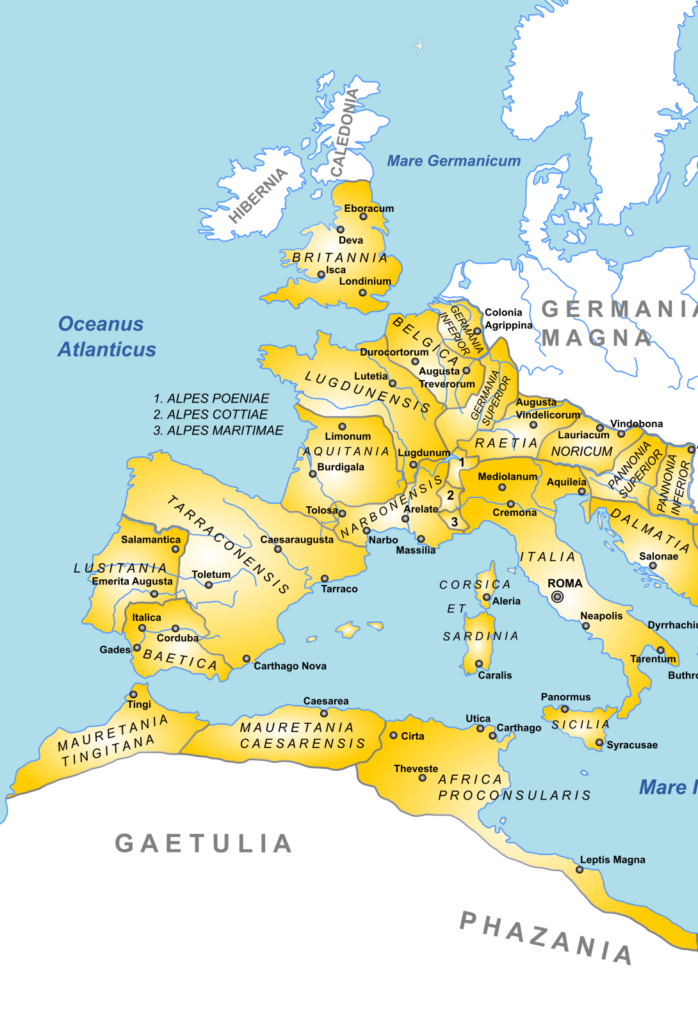

Earthshaking as this transition was for the world around Egypt, it was greeted with little more than a weary acquiescence inside the breadbasket of the empire. The ordinary people of Egypt may have felt a certain fondness for Cleopatra, that first ruler in centuries who had bothered to learn their language, but they felt little enough love for the rest of her clan. Taxes under the Romans were no more egregious than they had been under the Ptolemies — if anything, they were probably less so — and the infrastructure improvements and increases in efficiency which the Roman civil administrators brought with them likely improved the life of the average Egyptian farmer to at least a modest degree. For the most part, though, life beside the Nile continued as it had for thousands of years before these latest foreign overlords had arrived, and as it would continue to do after they left again. There is a timelessness about the day-to-day life of Egypt which has been both a blessing and a tragedy down through the country’s long history.
Within the urban environs of Alexandria, however, the change in government was more noticeable, and quite probably even more welcome. Public-works projects were initiated by the provincial governor to repair streets and façades, causeways and conduits that had been damaged during the fighting of 48 and 47 BC, and neglected for decades before that. The Alexandria envisioned by Dinocrates all those years ago — the city of wide boulevards and leafy parks, of gleaming marble and granite, of gurgling fountains and lush greenery — was displayed to its best effect once again. The old royal palace of the Ptolemies, that locus of decadent pleasure, became something more akin to a modern city hall in the hands of the practical, efficient Romans. It was soon populated by many of the Jews of Alexandria, who didn’t miss a beat in the transition, assuming the same place they had occupied under the Ptolemies: that of the government’s bureaucrats and scribes.
But the Romans were not only restorers of old things and ways; they also added fresh wonders to the city’s collection of same. In the final years of her reign, Cleopatra had begun the construction of an enormous monument to Mark Antony, situated on a promontory so as to be visible from the harbor below. It was left to the Romans to finish it, rededicating it in the process to Caesar Augustus; it became the ultimate celebration of Roman rule over Alexandria and all of Egypt. In circa AD 30, an Alexandrian Jew named Philo described the complex known as the Caesareum in writing:
There is elsewhere no precinct like that which is called the Caesareum, a temple to Augustus, situated on an eminence facing the harbor, huge and conspicuous, fitted on a scale not found elsewhere with dedicated offerings, around it a girdle of pictures and statues in silver and gold, forming a precinct of vast breadth, embellished with porticoes, libraries, chambers, groves, gateways, and wide open courts, and everything which lavish expenditure could produce to beautify it — the whole a hope of safety to the voyager either going into or out of the harbor.
A pair of 1300-year-old obelisks, dating from the reign of the Eighteenth Dynasty pharaoh Thutmose III, were transported from the city of Heliopolis to Alexandria and set up as the centerpiece of the Caesareum. They were eventually joined by a third obelisk from Luxor, dating from the reign of the famed Nineteenth Dynasty pharaoh Ramses II. Millennia later, they would be recovered from the ruin of the Caesareum, and be stood up incongruously in the urban centers of New York, London, and Paris, part of a wholesale looting of Egyptian antiquities which the author Brian Fagan has indelibly dubbed “the rape of the Nile.” They are popularly known even today as “Cleopatra’s Needles,” a name stemming from the time before scholars could read their hieroglyphic inscriptions, and thus mis-attributed their date of creation to a much later era of Egyptian history.
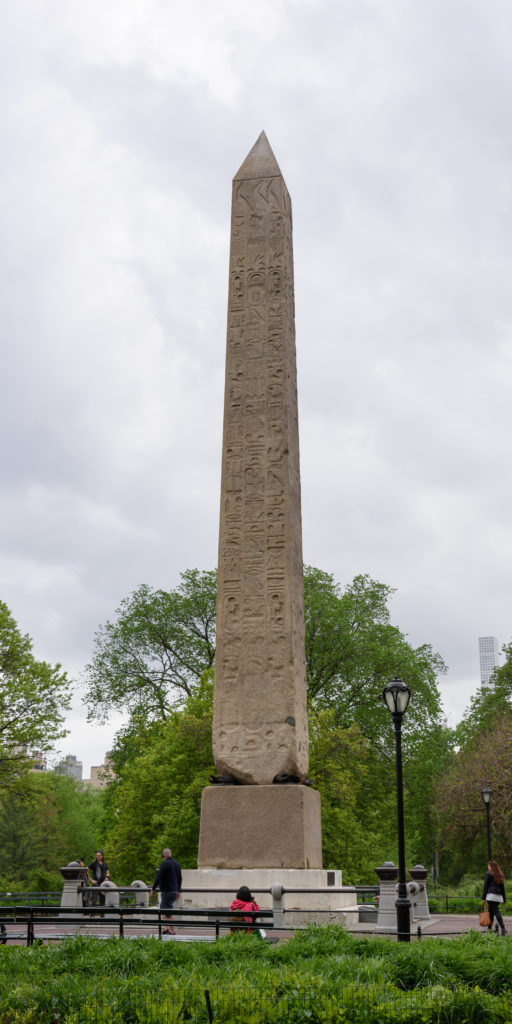
While the Caesareum was no doubt awe-inspiring, the real soul of the new Alexandria lived at the temple complex known as the Serapeum. It had originally been constructed during the reign of Ptolemy III as another way of cementing the artful union between Egyptian and Greek which he, his father, and his grandfather had so cleverly brought off. The god to which it was dedicated was Serapis, a new one invented specifically to advance that agenda. In physical appearance, Serapis was a mixture of Egyptian and Greek traits, and he likewise combined the spiritual qualities of gods from both cultures. Because the Romans worshiped largely the same set of gods as the Greeks, albeit using Latin rather than Greek names for them, Serapis was equally useful for them. In fact, they remodeled and greatly expanded his temple complex, and made him the official patron deity of Alexandria.
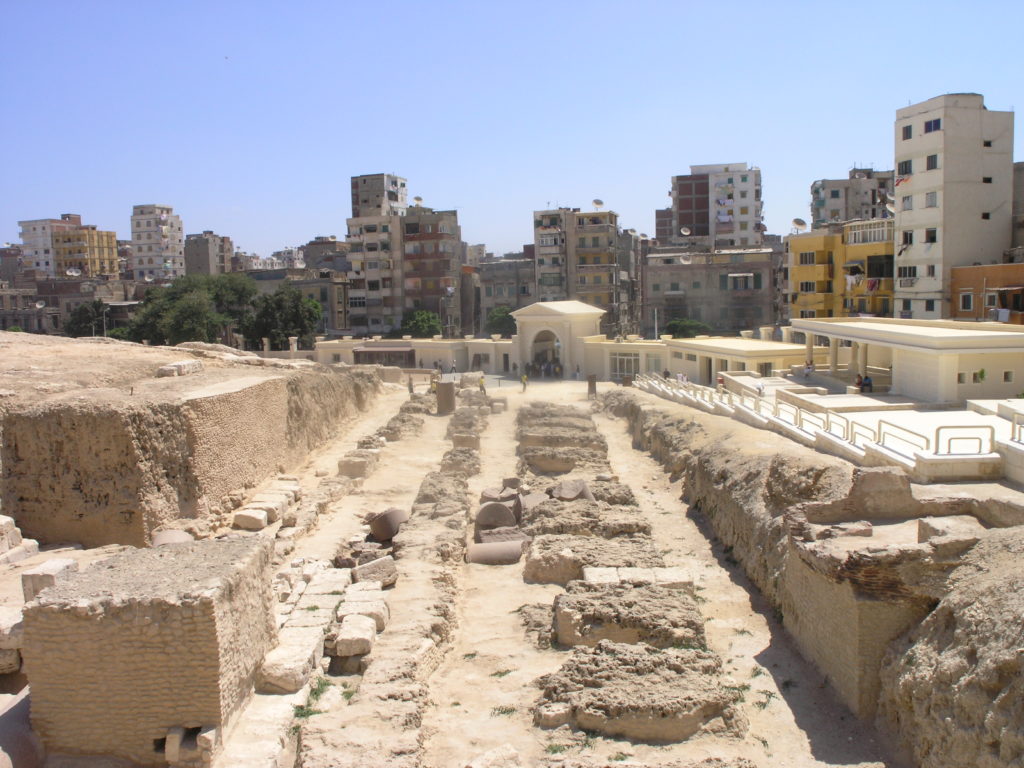
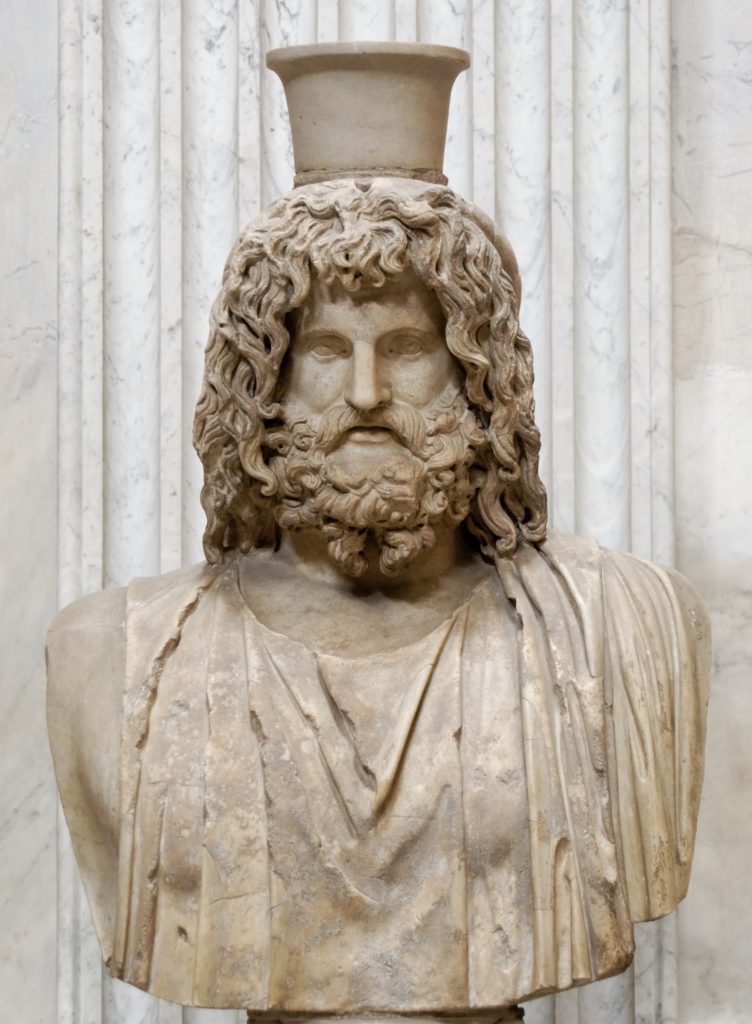
Around AD 50, an Alexandrian orator named Dio delivered a paean to his city, a place that was now thriving more than ever, the cosmopolitan melting pot of a Roman Empire that was also near its historical peak.
Not only have you a monopoly of the shipping of the entire Mediterranean because of your harbors, the magnitude of your fleet, and the abundance and marketing of the products of every land, but also the outer waters that lie beyond are in your grasp, both the Red Sea and the Indian Ocean. The result is that trade, not merely of islands, ports, a few straits and isthmuses, but of practically the whole world is yours. For Alexandria is situated, as it were, at the crossroads of the whole world, of even the most remote nations, as if it were a market serving a single city, bringing together all men into one place, displaying them to one another and, as far as possible, making them of the same race.
Out of decadence and corruption, war and tragedy, Alexandria had been reborn in the image of its original, best self. If it could no longer claim to be the largest city in the known world, its lively beauty could still rival even that of Rome. It became one of the most popular destinations for a new phenomenon in the history of the world: mass tourism. By the first century AD, wealthy Romans and provincials were being disgorged in ever increasing numbers from the ships in its harbors, to tour the city streets and climb up to the terraces of the Lighthouse of Alexandria, and then to board other boats that sailed up the Nile to the Pyramids of Giza and other remnants of Egypt’s past. The upper crust of Alexandrian society complained to one another about these uncouth foreigners chattering in their harshly staccato language of Latin — so different from the softer, subtler melodiousness of their own Greek — but didn’t hesitate to pocket their money.
Alexandria again became a magnet for scholars as well, who were attracted by the energy of the life there and by a spirit of intellectual freedom that still held sway there within reasonable limits. It was once again as idyllic a place to study and debate as could be found anywhere in the classical world; once again it was the world’s undeniable leader in engineering, mathematics, and science. Before we allow the tides of history to sweep us any further, then, we should pause to appreciate this second great flowering of the spirit of Euclid, Archimedes, Aristarchus, and Eratosthenes in their old home of Alexandria.
(A full listing of print and online sources used will follow the final article in this series.)
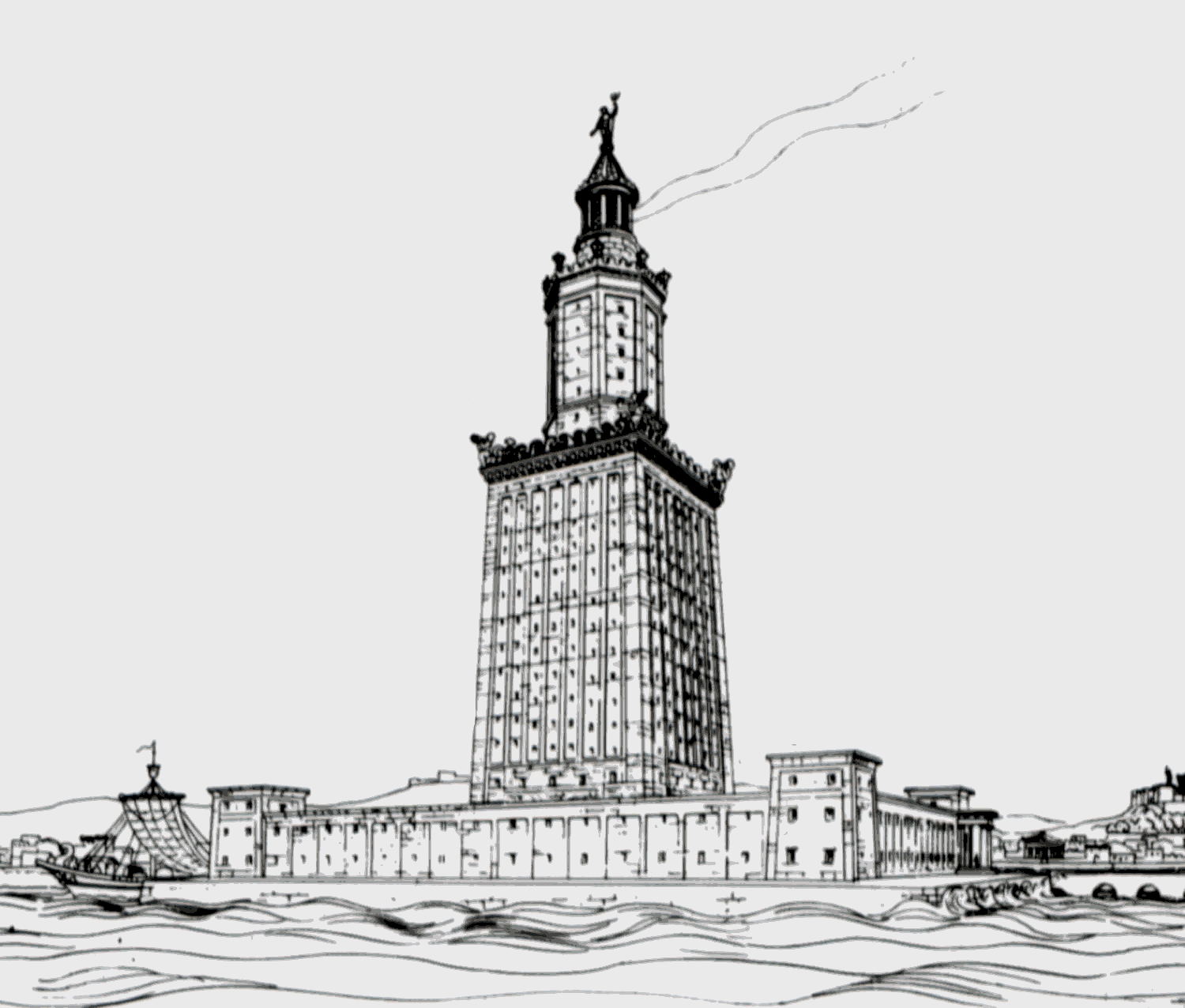
Peter Olausson
“Suesonius” > Suetonis
Curious tale about Alexander’s nose. True or not, de-nosing was very common indeed in Egypt, from small statues to the Sphinx.
Jimmy Maher
Thanks!
Ross
I imagine that of the body parts prone to breaking off an embalmed body, the nose is the only one that wouldn’t have been secured against the body and/or covered for the sake of modesty.
Aula
“the old Republicans worst nightmare”
Republicans’
Jimmy Maher
Thanks!
Leo Vellés
Great article to a great series, seems like the ending. We are moving to China now or there are a few more articles about this subject? It sure is gripping for me to learn more about the Roman Empire, but now that Alexandria’s tale come full circle, it seems the only story left to be told is how both the library amd the lighthouse met their demise
Jimmy Maher
There’s quite a bit more to come. I want to tell Alexandria’s story all the way to the Arab conquest. A big part of that later story is the conflict between the old ways and the emerging new religion of Christianity, of which Alexandria was a locus. In my opinion, this is too often presented in a rather simplistic way that has more to do with present-day culture wars than the context of the times. (Catherine Nixy’s recent bestseller The Darkening Age was a notable offender.) So, I’m anxious to offer a more nuanced take.
Michael Waddell
Looking forward to that!
Will Moczarski
Lighthouse of Alexandra -> Alexandria
Jimmy Maher
Thanks!
Paul
I may misremember details, but there’s a tale of emperor Otto III. opening Charlemagne’s Krypta in Aix-la-Chapelle shortly before 1000 AD. He broke off the nose, too, and had it replaced with a golden one. I imagine the chronicler was familiar with Suetonius. Never realized the parallel before, and would love to hear more de-nosing stories.
Fredrik Arnerup
Well, the astronomer Tycho Brahe Lost part of His nose in a duel and had to wear a prosthetic nose that was said to be made of gold and silver. But that was while he was still alive.
Alexey
> Caesarion rather than she was, technically speaking, the very last living Ptolemaic monarch
Technically speaking, Cleopatra Selene’s son was a later Ptolemaic ruler (just of Mauretania, not Egypt) as she married a vassal king (https://www.badancient.com/claims/final-ptolemaic-ruler/). Or maybe you don’t count him as a monarch because he was subordinate to Rome?
Jimmy Maher
Yes, exactly. History considers Ptolemaic Egypt to have ended with the Roman conquest in 30 BC.